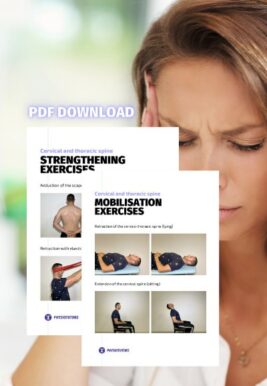Learn
Tension-Type headache | Headache & Dizziness Assessment
Headaches can manifest on their own but are also a very common symptom in neck pain patients as more than 60% of patients with a primary neck pain complaint report having concordant episodes of neck pain. Therefore it’s essential to find out what kind of headache the patient is suffering from.
To start off let’s differentiate between primary and secondary types of headaches. But what does this mean? Simply put, primary headaches are a “disease themselves” whereas, in secondary headaches, the headache is a symptom of another condition. So primary headaches would be migraines, tension-type headaches, cluster headaches, and medication overdose headaches. Secondary type headaches are headaches caused by tumors, hemorrhage, other trauma, TMJ dysfunction, or neck pain aka. The Cervicogenic headache.
Now let’s take a closer look at tension-type headaches, which are primary types of headaches.
Tension-type headaches have a mean 1-year prevalence of 48,6% around the world with women being equally as often affected as men in an age range between 20-40.
In order for a headache to qualify as a tension-type headache it has to fulfill certain criteria:
Tension-type headaches can vary from infrequent episodic, frequent episodic, to chronic as seen in this table:

While the frequency and duration differ, patients in all three categories need to report at least 2 of the following four characteristics:
- The headache is bilateral
- It has a pressing or tightening quality but NOT pulsating
- The intensity is mild to moderate so a patient will usually still be able to complete ADLs as
- The headache is not aggravated by routine physical activity such as walking or climbing stairs.
Also, there is:
- NO nausea or vomiting
- No more than one of photophobia or phonophobia which is sensitivity to light and sounds respectively
100% FREE HEADACHE HOME EXERCISE PROGRAM

Tools you can use to assess the impact of a headache on your patient are the HIT-6 questionnaire which you can find in the video description. Also note that it can be difficult for a patient to answer all of the questions on duration, intensity, and characteristics of their headache during your assessment. Therefore asking them to complete a headache diary can help in the assessment and management of the headache and you should be aware that there can be overlap between multiple headache disorders.
If you would like to learn how to diagnose other common forms of headaches, check out the posts below:
The Watson Test is a common provocation test used in the assessment of tension-type headaches and migraines.
References:
Like what you’re learning?
BUY THE FULL PHYSIOTUTORS ASSESSMENT BOOK
- 600+ Pages e-Book
- Interactive Content (Direct Video Demonstration, PubMed articles)
- Statistical Values for all Special Tests from the latest research
- Available in 🇬🇧 🇩🇪 🇫🇷 🇪🇸 🇮🇹 🇵🇹 🇹🇷
- And much more!








